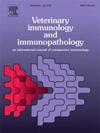肿瘤坏死因子-α (TNF-α)、降钙素原 (PCT)、白细胞介素-6 (IL-6) 和aptoglobin (HP) 对新生儿腹泻犊牛诊断和预后重要性的研究。
IF 1.4
3区 农林科学
Q4 IMMUNOLOGY
引用次数: 0
摘要
本研究旨在探讨降钙素原、肿瘤坏死因子-α、白细胞介素-6和嗜血红蛋白水平对根据腹泻严重程度分类的犊牛预后的影响。动物材料包括 48 头不同品种和性别、年龄在 1-30 天的腹泻犊牛,以及 16 头年龄在 1-30 天的健康犊牛。使用的 48 头腹泻犊牛分为 3 组,每组 16 头。第 1 组为病毒性腹泻(罗塔菌 + 冠状病毒 n = 16),第 2 组为细菌性腹泻(大肠杆菌 n = 16),第 3 组为寄生虫性腹泻(隐孢子虫病 n = 16)。每组又分为两个亚组(中度亚组和重度亚组)。在治疗前(0 小时)、治疗后 24 小时和 72 小时分别采集腹泻犊牛的血样。进行了全血细胞计数、生化、血气分析和酶联免疫吸附试验。研究发现,48 头腹泻小牛中有 18.75%(9/48)死亡,81.25%(39/48)存活。在各组患者中,死亡率最高的是重症轮状病毒+电晕组(37.5%)。在 0 小时和 24 小时内,发现罗塔-电晕组和大肠杆菌组腹泻犊牛的平均 PCT 浓度高于健康犊牛和隐孢子虫属组腹泻犊牛(P本文章由计算机程序翻译,如有差异,请以英文原文为准。
Investigation of the diagnostic and prognostic importance of Tumor Necrosis Factor-alfa (TNF-α), Procalcitonin (PCT), Interleukin-6 (IL-6) and Haptoglobin (HP) in calves with neonatal diarrhea
This study aims to investigate the effects of Procalcitonin, Tumor Necrosis Factor-alpha, Interleukin-6, and Haptoglobin levels on the prognosis of calves classified according to the severity of diarrhea. The animal material comprised 48 diarrheic calves of different breeds and sexes, aged 1‐30 days, and 16 healthy calves aged 1–30 days. The 48 diarrheic calves used were divided into 3 groups, each consisting of 16 calves. Group 1 was designed as Viral (Rota + Corona n = 16), Group 2 as Bacterial (E. coli n = 16), and Group 3 as Parasitic (Cryptosporidiosis n = 16). Each of these groups was further divided into 2 subgroups (moderate and severe subgroups). Blood samples were taken from the diarrheic calves before treatment (0 h) and at 24 and 72 h after treatment. Complete blood count, biochemical, blood gas analyses, and ELISA tests were performed.
It was determined that 18.75 % (9/48) of the 48 diarrheic calves included in the study died, while 81.25 % (39/48) survived. The highest mortality rate among the patient groups was observed in the severe rota + corona group (37.5 %).
The average PCT concentration in the diarrheic calves in the Rota-corona and E. coli groups at 0 and 24 hours was found to be higher than both the healthy calves and the diarrheic calves in the Cryptosporidium spp. group (P<0.001). This increase was also observed in the Cryptosporidium spp. group at 72 h (P<0.001). A positive and moderate correlation was observed between Procalcitonin and TNF-α (r = 0.603, P<0.001). As a result, it was concluded that the Procalcitonin value, along with other tests, could be used as a biomarker to determine the prognosis of the disease in diarrheic calves, regardless of the etiological agent. This study was evaluated as an original study in which cytokines and acute phase proteins were investigated before and after treatment, with diarrhea divided into subgroups.
求助全文
通过发布文献求助,成功后即可免费获取论文全文。
去求助
来源期刊
CiteScore
3.40
自引率
5.60%
发文量
79
审稿时长
70 days
期刊介绍:
The journal reports basic, comparative and clinical immunology as they pertain to the animal species designated here: livestock, poultry, and fish species that are major food animals and companion animals such as cats, dogs, horses and camels, and wildlife species that act as reservoirs for food, companion or human infectious diseases, or as models for human disease.
Rodent models of infectious diseases that are of importance in the animal species indicated above,when the disease requires a level of containment that is not readily available for larger animal experimentation (ABSL3), will be considered. Papers on rabbits, lizards, guinea pigs, badgers, armadillos, elephants, antelope, and buffalo will be reviewed if the research advances our fundamental understanding of immunology, or if they act as a reservoir of infectious disease for the primary animal species designated above, or for humans. Manuscripts employing other species will be reviewed if justified as fitting into the categories above.
The following topics are appropriate: biology of cells and mechanisms of the immune system, immunochemistry, immunodeficiencies, immunodiagnosis, immunogenetics, immunopathology, immunology of infectious disease and tumors, immunoprophylaxis including vaccine development and delivery, immunological aspects of pregnancy including passive immunity, autoimmuity, neuroimmunology, and transplanatation immunology. Manuscripts that describe new genes and development of tools such as monoclonal antibodies are also of interest when part of a larger biological study. Studies employing extracts or constituents (plant extracts, feed additives or microbiome) must be sufficiently defined to be reproduced in other laboratories and also provide evidence for possible mechanisms and not simply show an effect on the immune system.

 求助内容:
求助内容: 应助结果提醒方式:
应助结果提醒方式:


